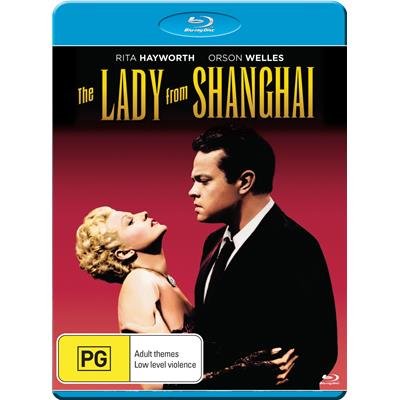Lady From Shanghai, The (Blu-ray) (1947) |
|
Lady From Shanghai, The (Blu-ray) (1947) |
|


|
| BUY IT |
| General | Extras | ||
| Category | Film-Noir |
Audio Commentary Audio-Only Track-Podcast Featurette Biographies-Cast Gallery-Photo Gallery-Poster Trivia |
|
| Rating |

|
||
| Year Of Production | 1947 | ||
| Running Time | 87:30 | ||
| RSDL / Flipper | No/No | Cast & Crew | |
| Start Up | Menu | ||
| Region Coding | 4 | Directed By | Orson Welles |
|
Studio
Distributor |
 ViaVision |
Starring |
Orson Welles Rita Hayworth |
| Case | Standard Blu-ray | ||
| RPI | ? | Music | None Given |
| Video | Audio | ||
| Pan & Scan/Full Frame | None |
English Dolby TrueHD 2.0 mono English Audio Commentary Dolby Digital 2.0 |
|
| Widescreen Aspect Ratio | None | ||
| 16x9 Enhancement |
 |
||
| Video Format | 1080p | ||
| Original Aspect Ratio | 1.37:1 | Miscellaneous | |
| Jacket Pictures | No | ||
| Subtitles | None | Smoking | No |
| Annoying Product Placement | No | ||
| Action In or After Credits | No | ||
Back in 1948 Orson Welles was pretty much on the nose in Hollywood, having developed a bad reputation from his films, Citizen Kane and The Magnificent Ambersons. There were on-set controversies, a reputation for cost overruns and clashes with the studios. As the story goes he was staging a musical on Broadway and ran out of cash, needing $50,000 to pay for costumes. In order to solve this problem, he rang the head of his then wife Rita Hayworth's studio and offered him a deal. The deal he offered was to star in and direct a film for the studio with a total fee of $50,000. When asked what the film would be about, he grabbed a paperback from a shelf of books near the pay phone he was using, seemingly a random. The novel he grabbed, If I Die Before I Wake by Sherwood King was quickly adapted by Welles himself and renamed, The Lady from Shanghai. Supposedly, he rushed the screenplay and was constantly rewriting it throughout filming leading to tension with the cast and studio. The film was savaged by the US critics despite positive reception in Europe and bombed at the box office. There was controversy especially about the fact that Hayworth’s long red hair was cut short and blonded for the film, amongst other things. Supposedly Welles was unhappy with the final cut made by the studio and the addition of what he felt was a very ordinary score. Since the film's original release, movie historians now generally consider it to be a classic and very different film-noir, even going so far as to refer to it as the only film-noir comedy ever made! (Although that is going too far, despite some eccentricities in performance and dialogue).
The story is quite convoluted and occasionally difficult to follow, however this is not necessarily a drawback for noir. The basic construct is that an Irish sailor visiting New York, Michael O'Hara (Welles) is wandering through Central Park when he notices a beautiful woman riding in a horse drawn carriage and offers her a cigarette. After she continues on her way, he sees her being dragged into bushes by a gang of men. He immediately rescues her earning more interest from her. Realising he is a sailor, she offers him a job on her husband's yacht as the bosun. They are heading out from New York the next day for a cruise through the Caribbean, Panama Canal, up the coast of Mexico and on to San Francisco. He refuses not wanting to get mixed up between a beautiful woman and her rich husband. Her husband is a well-known, successful defence lawyer, Arthur Bannister (Everett Sloan) and as he finds out later her name is Elsa (Rita Hayworth). Bannister is crippled and has a business partner in the slimy and eccentric George Grisby (Glenn Anders). The next day as he tries to arrange a job for himself, her husband turns up again offering him the job on the yacht. O'Hara agrees to a drink but doesn't plan to accept the job. After a number of drinks, Bannister cannot walk and O'Hara takes him back to the boat. Eventually Bannister, his wife, her cook and others talk him into taking the job on what becomes a stranger and stranger cruise the longer it goes on. Grisby also comes along for the ride. Soon O'Hara realises that various members of the party have plans, many of which involve them getting his assistance whether willingly or otherwise. A convoluted murder plot ensues. Who will get killed? Who will do it and who will get tried for the crime?
This is a wonderful and very different noir, featuring fantastic cinematography with lots of interesting angles, shadows and a very stylish look. The dialogue is great, despite not always immediately making sense. The final sequence set in a hall of mirrors is justifiably famous, however Welles intended it to be much longer. It actually reminds me of Enter the Dragon's final sequence but this is obviously the forerunner of that film. The acting is generally excellent, with Glenn Anders being very eccentric as the slimy partner. I tend to agree with Orson Welles’ view of the score used here as it often seems written for a different film. According to extras on the disc, he included some music on the cut he submitted to the studio expecting them to get something similar done professionally, however, they went for a completely different feel. There are loads of fascinating scenes such as the picnic on the beach where they discuss sharks. The opening sequence seems rushed and doesn't really stand up to the quality of the rest of the film.
Fans of noir definitely need to see this lesser known work of Orson Welles. Highly Recommended.
This video transfer looks very good for a film of this vintage. It is black and white with quite good contrast and clarity although there is some black crush at times. In Region A this film has been released on Blu-ray three times, with this version replicating the second TCM edition, utilising the AVC codec. See the region comparison section below for details of the various versions. There is film grain throughout as you would expect, although it does become intrusive in a couple of scenes. Technically, it is 1080p at the original aspect ratio of 1.37:1. It is not a perfect transfer, however it is certainly of very good quality for a film of this age. The more recent US Edition does seem to have slightly better video quality according to the comparison here.
There are no subtitles despite what it says on the case.
| Sharpness | |
| Shadow Detail | |
| Colour | |
| Grain/Pixelization | |
| Film-To-Video Artefacts | |
| Film Artefacts | |
| Overall |
The soundtrack is in English Dolby TrueHD 2.0 mono plus a commentary in Dolby Digital 2.0. Again this replicates the second TCM release in Region A upgrading from the initial Dolby Digital. The dialogue is nice and clear throughout and the music sounds good despite its lack of quality from a scoring perspective. This is a quality track for a movie of this vintage.
| Dialogue | |
| Audio Sync | |
| Clicks/Pops/Dropouts | |
| Surround Channel Use | |
| Subwoofer | |
| Overall |
A great selection of extras. The best I have seen on a release for ages.
The menu is simple, silent and still.
A short but interesting introduction to the film probably as shown on TCM.
42 publicity shots from the release of the film.
36 stills from scenes.
11 shots with captions. Interesting.
10 posters with captions.
10 lobby cards.
Interesting audio feature of a film critic talking about the film and its place in noir. Certainly interesting for noir fans.
Text extra about the film including the link to Errol Flynn.
Detailed text biography.
Three separate discussions where this noted noir author and critic discusses this film. Sections are 'Epic Noir Poem' where he discusses his views on the film and its eccentricities, 'Back Story' where he discusses how the film got made, the source novel, casting and more and 'It's Film Noir Distilled' where he discusses its place amongst noir and how it references other films. All are interesting and worth watching.
This commentary is based on his long relationship with Welles based on interviews with him to write a biography. He uses specific quotes from Welles and other anecdotes to explain the film. Fascinating insights.
NOTE: To view non-R4 releases, your equipment needs to be multi-zone compatible and usually also NTSC compatible.
As I mentioned above this film has been released on Blu-ray three times in Region A and our local release replicates what is probably the best of them. A more recent Mill Creek release has slightly better video based on the comparison here however does not contains any of the excellent extras. Buy local.
The video quality is very good.
The audio quality is very good.
The extras are excellent.| Video | |
| Audio | |
| Extras | |
| Plot | |
| Overall |
| Review Equipment | |
| DVD | Panasonic DMR-PWT500, using HDMI output |
| Display | Sharp LC52LE820X Quattron 52" Full HD LED-LCD TV . Calibrated with Ultimate DVD Platinum. This display device is 16x9 capable. This display device has a maximum native resolution of 1080p. |
| Audio Decoder | Built into amplifier. Calibrated with Ultimate DVD Platinum. |
| Amplification | Marantz SR5005 |
| Speakers | Monitor Audio Bronze 2 (Front), Bronze Centre & Bronze FX (Rears) + Sony SAW2500M Subwoofer |